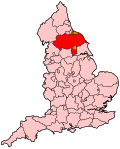| From | Legislation | Limits | Area | Notes |
|---|
| Medieval | Prescription | The ancient borough, or "city and liberty", of York. [1] | 2,720 acres (1,100 ha) [2] | A freeman borough in which freedom of the city ("citizenship") could be acquired by patrimony (inheritance), servitude (apprenticeship) or purchase. [3] [1] [4] The "city" was the medieval walled city, but the boundary of the surrounding "liberty" was uncertain. [1] [4] The Minster Yard, an extra-parochial place around York Minster, was excluded from the ancient and parliamentary borough, [1] as was York Castle. [4] Although the Ainsty to the west of the city was annexed to the county of the city in 1449 by letters patent, [5] it was not annexed to the borough; patrimony or servitude in the Ainsty did not make one eligible for citizenship, [1] and Ainsty forty shilling freeholders voted for Yorkshire MPs (confirmed in 1736 [4] [6] ) rather than York MPs. [3] Freeholdings within the borough gave no franchise. [3] [7] |
| 1832 | Parliamentary Boundaries Act 1832 | The ancient borough plus two extensions encompassing urbanised parts of the adjoining townships: one to the north, through Clifton and Heworth between the River Ouse and Tang Hall Beck; the other to the southeast through Fulford. [1] [8] | 2,789 acres (1,129 ha) [9] | The Parliamentary Boundaries Act specified the complete boundary explicitly, to resolve uncertainty over the extent of the "liberty", [8] [1] especially at the Knavesmire, unresolved until the Ordnance Survey mapped the area in detail in 1852. [4] [10] |
| 1885 | Redistribution of Seats Act 1885 | The previous parliamentary borough of York plus the current (1884 [10] ) boundaries of the municipal borough of York. [11] | 3,591 acres (1,453 ha) [12] | The Representation of the People Act 1884 was a partial reform from a property-based franchise towards a residence-based one, with a grandfather clause protecting those who would otherwise have lost their vote. The broader municipal boundary defined the reformed franchise, while the older parliamentary boundary was for the grandfathered property owners. |
| 1918 | Representation of the People Act 1918 | The current (1893 [10] ) boundaries of the county borough and city of York, including York Castle. [13] | 3,730 acres (1,510 ha) [14] [15] | The representation was also reduced from two members to one. As late as 1951 there was uncertainty over whether the Municipal Corporations Act 1835 had brought the castle within the municipal borough (county borough from 1889); [16] it was included explicitly by the 1918 act but implicitly by the 1948 act. |
| 1950 | Representation of the People Act 1948 | The current (1937 [10] ) boundaries of the county borough and city of York. | 6,409 acres (2,594 ha) [15] | Consequent on the Initial Review of Westminster constituencies |
| 1964 | Parliamentary Constituencies (Leeds, York and Barkston Ash) Order, 1960 [17] | The current (1957 [17] ) boundaries of the county borough and city of York. | 6,933 acres (2,806 ha) [15] [18] | Consequent on the 1959 report of the Boundary Commission for England [19] |
| Feb. 1974 | Parliamentary Constituencies (England) Order 1970 [20] | The current (1968) boundaries of the county borough and city of York. | 2,946 hectares (7,280 acres) [21] | Consequent on the Second Periodic Review of Westminster constituencies |
| 1983 | Parliamentary Constituencies (England) Order 1983 [22] | The current (1968) boundaries of the non-metropolitan district and city of York. | 2,946 hectares (7,280 acres) [23] | Consequent on the Third Periodic Review of Westminster constituencies |
| 1997 | Parliamentary Constituencies (England) Order 1995 [24] | The current (1968) boundaries of the non-metropolitan district and city of York. | | Consequent on the Fourth Periodic Review of Westminster constituencies. The name of the constituency was also changed from "York" to "City of York". The non-metropolitan district of York was abolished in 1996 and subsumed into a new, larger, unitary authority named the City of York; [25] however, this did not affect the parliamentary constituency boundary. |







